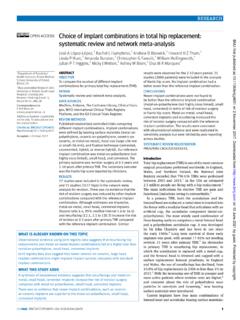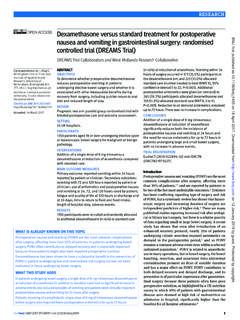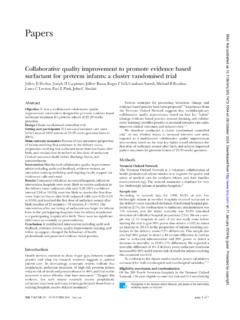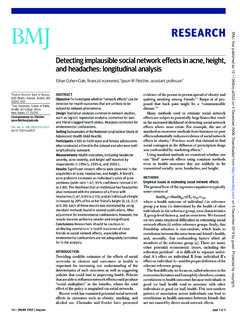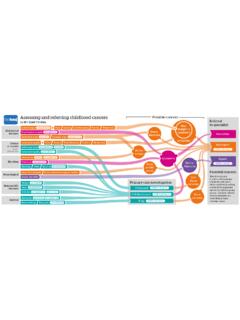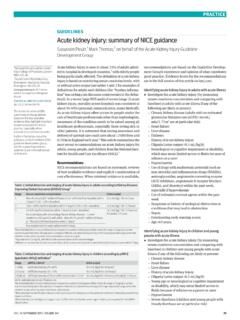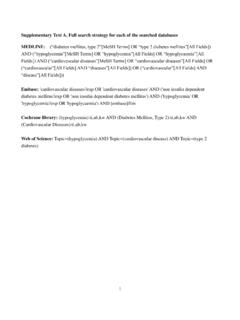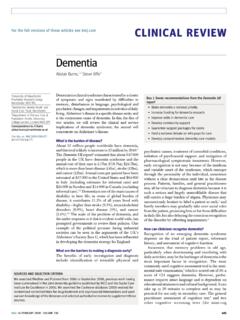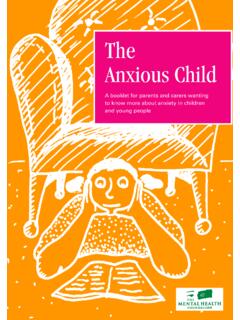Transcription of Developmental assessment of children - BMJ
1 BMJ | 19 JANUARY 2013 | VOLUME 346 31 CLINICAL REVIEW migration, connection, pruning, and myel ination, and it per-sists through at least the second decade. This fundamental phenomenon, which determines brain development, is a preprogrammed process that occurs in all is normal development?The pattern of development is remarkably constant, within fairly broad limits, but the rate at which goals are achieved varies from child to child. Skills are acquired sequentially, with one goal acquired after another. Later goals often depend on achievement of earlier goals within the same field for example, children must learn to sit independently before they can stand and then of normal development, linked to the ability to perform a particular task at a particular age, relate to the performance of the average child. The acquisition of a key performance skill, such as walking, is referred to as a mile-stone.
2 For each skill, the normal age range for attainment of the milestone varies widely. A median age is the age at which half a population of children acquire a skill. A limit age is the age at which a skill should have been achieved and is two standard deviations from the mean. It is important to know which milestones are most consistent. Smiling socially by the age of 8 weeks is a consistent milestone, whereas crawl-ing is not. Crawling occurs at a widely varying time point, and some children with normal development never learn to factors may determine the fundamental devel-opmental potential, but environmental factors have crucial influences on the profile achieved. Positive experiences dur-ing early childhood may enhance brain development, partic-ularly in the area of linguistic and social skills. Unfortunately, however, the brain is also vulnerable to various insults, par-ticularly in the early embryonic stages, but also in later life (box 1).
3 Studies on abandoned Romanian children provide good evidence of how an adverse environment affects brain growth. children who were institutionalised have smaller brains than those who were adopted abroad or brought up in a family environment, including foster care in Developmental assessment is the process of mapping a child s performance compared with children of similar age. The comparison group is obtained from a representative sample of the population that the child comes from. Several factors contribute to performance varying greatly between different population In a multicultural society it can be chal-lenging to find appropriate benchmarks for these article reviews the literature on the assessment of child development. It aims to highlight what normal Developmental parameters are, when and how to assess a child, and when to refer for specialist is child development?Development is the process by which each child evolves from helpless infancy to independent and development of the brain and central nervous system is often termed psychomotor development and is usu-ally divided into four main domains: Gross and fine motor skills Speech and language Social and personal and activities of daily living Performance and brain development starts by the fourth week of gesta-tion and progresses rapidly throughout intrauterine life and early childhood.
4 Brain development the target of develop-mental surveillance and screening reflects neurological maturation. It consists of a complex process of cell growth, 1 Department of Paediatrics, Royal Free Hospital, London NW3 2QG, UK2 Department of Child Health, Birmingham Community Healthcare NHS Trust, Birmingham, UK3 Department of Pediatrics, Boston University, Boston, MA, USAC orrespondence to: M Bellman this as: BMJ 2013;346: e8687 doi: assessment of childrenMartin Bellman,1 Orlaith Byrne,2 Robert Sege3 SUMMARY POINTSE very consultation is an opportunity to ask flexible questions about a child s development as part of comprehensive medical careParents who voice concerns about their child s development are usually rightLoss of previously acquired skills (regression) is a red flag and should prompt rapid referral for detailed assessment and investigationParents and carers are usually more aware of norms for gross motor milestones, such as walking independently, than for milestones and patterns of normal speech, language acquisition, and play skills.
5 Consider targeted questioningConsider use of Developmental screening questionnaires and measurement tools to supplement clinical judgment Follow the link from the online version of this article to obtain certi ed continuing medical education creditsSOURCES AND SELECTION CRITERIAWe searched PubMed, the Cochrane Database of Systematic Reviews, and reference lists of relevant publications using the subject headings and key words development , Developmental assessment , Developmental delay , disability , mental retardation , Developmental screening tools , screening , and diagnosis . We also reviewed guidelines from the American Academy of Pediatrics2 and the UK Healthy Child have extensive clinical experience in Developmental paediatrics in the United Kingdom and United States, which we drew on to comment on the extensive and potentially confusing technology currently used for Developmental 1 | Environmental causes of damage to brain developmentAntenatalEarly maternal infections, such as rubella, toxoplasma, cytomegalovirusLate maternal infections, such as varicella, malaria, HIVT oxins for example, alcohol, pesticides, radiation, smokingDrugs for example, cytotoxics, antiepilepticsPostnatalInfections for example, meningitis, encephalitis, cytomegalovirusMetabolic disorders, such as hypoglycaemia, hyponatraemia or hypernatraemia, dehydrationToxins for example, lead, mercury, arsenic, chlorinated organic compounds, solventsTrauma.
6 Especially head injurySevere understimulation, maltreatment, or domestic violenceMalnutrition, especially deficiency of iron, folate, and vitamin DMaternal mental health disorders, most commonly depression32 BMJ | 19 JANUARY 2013 | VOLUME 346 CLINICAL REVIEWBox 3 | Suggested opportunistic screening questions35Do you have any concerns about the way your child is behaving, learning, or developing?Do you have any concerns about the way he or she moves or uses his or her arms or legs?Do you have any concerns about how your child talks and understands what you say?Does your child enjoy playing with toys? Describe what he or she does while playingHas your child ever stopped doing something he or she could previously do?Does your child get along with others?Do you have any concerns about how your child is learning to do things for himself or herself?Other studies showed significant gains in cognitive and lan-guage skills after abandoned children are taken into 6 What is Developmental delay?
7 Many clinicians use the term global Developmental delay to mean a significant delay in two or more of the four main Developmental domains listed above. Significant delay is defined as performance two or more standard devia-tions below the mean on age appropriate standardised norm-referenced testing (usually a secondary care pro-cedure). In the United Kingdom and the United States, the term global Developmental delay is usually reserved for younger children (typically under 5 years of age). In the UK learning disability is usually applied to older chil-dren, when IQ testing is more valid and reliable (although formal testing of IQ is rarely performed in clinical prac-tice and the child s assessment is based on functional abilities). In the US, the term Developmental disability or mental retardation is used in the over 5 age term Developmental impairment or disorder covers a heterogeneous group of conditions that start early in life and present with delay or an abnormal pattern of progression in one or more Developmental domain.
8 children with autism spectrum disorder fall into this category. In this context, the use of the term Developmental delay has been challenged because it conveys a message that the child may catch up, which is often not Nevertheless, it remains in com-mon use because it is well understood by professionals and common are Developmental problems?Global Developmental delay affects 1-3% of children . About 1% (95% confidence interval 90-141 per 10 000) of children have an autism spectrum disorder,8 Structured assessment of a child s development aims mainly to clarify the quantity and quality of the child s devel-opmental status. However, the procedure also offers several advantages in terms of health promotion (box 2). children develop at different rates, and it is important to distinguish those who are within the normal range from those who are following a pathological course. We now have good evidence that early identification and early interven-tion improve the outcomes of children with Developmental 12A persuasive body of work, which reviewed evidence from neurosciences, Developmental psychology, social sciences, epidemiology (including animal and human studies), longi-tudinal studies, case series, and case reports,13-15 describes the importance of the early years in promoting healthy brain development.
9 This literature builds on the scientific under-standing of brain development and finds that environments that do not promote healthy development have a cumulative and ongoing negative impact on a range of social, economic, and learning outcomes over the life course. This body of work emphasises that early interventions are an effective way to improve children s outcomes than later the importance of the early years, early intervention is crucial. Early intervention seems to be even more impor-tant for children with Developmental disabilities than for children more generally, because learning is cumulative, and barriers to healthy development early in life impede development at each subsequent 17 Obviously, identification of abnormality must be followed by further action. children develop relentlessly, and if they are on a deviant path the course becomes more difficult to change as time goes by.
10 Early child health promotion, which includes support for parenting and treatment, is an effec-tive investment that may prevent the need for more inten-sive, costly, and often less effective intervention later on. A series of systematic reviews of strategies for improving child development in 13 relatively deprived countries, published in the Lancet, found good evidence that interventions at pre-school age are highly cost A linked editorial stated that Neglect of young children most in need is an outrage and a huge strategic mistake. 19 How do children present with Developmental problems? children with Developmental problems may present in sev-eral ways: In countries with routine child health surveillance or Developmental screening practices, concerns may be raised at scheduled contacts In children with identified risk factors (such as prematurity) who have undergone Developmental surveillance, Developmental problems may be detected early Parents may recognise a delay or be worried about a child s behaviour or social skills and seek professional Box 2 | Benefits of Developmental assessmentEarly diagnosis and interventionEarly diagnosis of conditions with a genetic basis, such as Duchenne muscular dystrophy and fragile X syndrome, facilitates genetic counselling for familiesProvides carers with reliable information before a Developmental problem becomes obvious and gives them more time to adjust to the child s difficulty and make appropriate management plans for their familyCarers are reassured and relieved of anxiety if assessment shows that the child is within the normal rangeEarly assessments can be compared with later ones.


